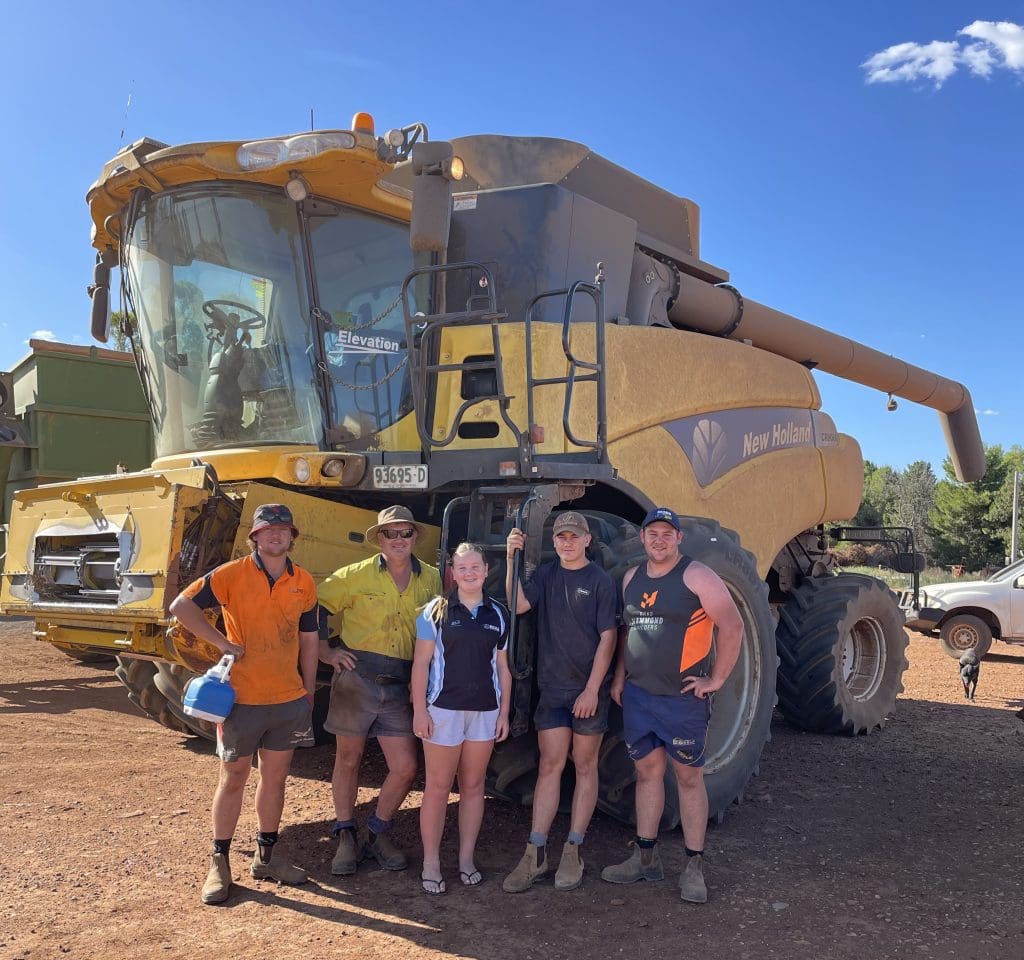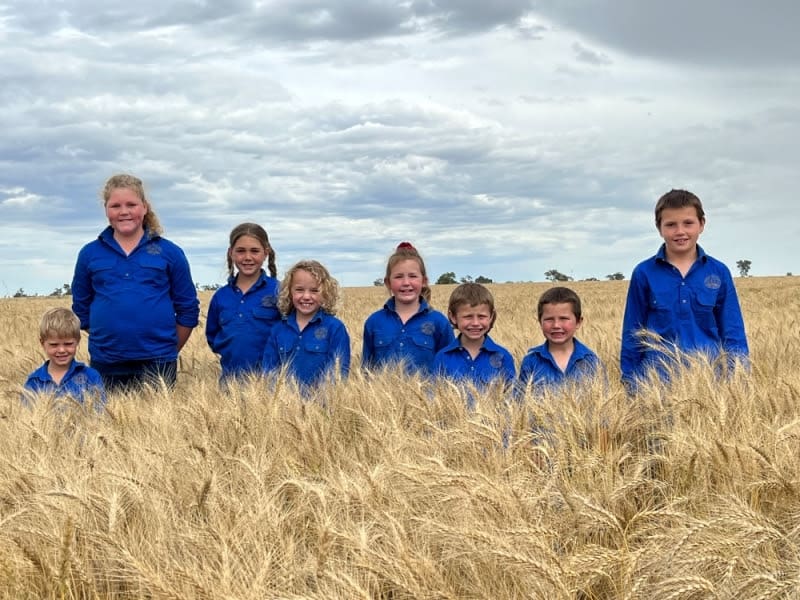A RUN of fine days has allowed growers in New South Wales to make some serious headway on harvest, and despite earlier rain and floods, and the challenge of some chewed-up or impassable roads, news from the paddock is not all bad.
Yields are generally above average, and growers lucky enough to be delivering APH or H1 wheat are seeing big premiums to reflect their rarity in this wet season where low protein and falling numbers are common.
In a state which has been pounded by flooding this year, an AFL pick for a Riverina family, and a profitable and educational project at Hermidale Public School have been highlights.
GWS call for header driver
At Binya, east of Griffith, Phil and Kirsty Rowston and family have had to rejig their harvest staffing following Tuesday’s news that son Harry was pick 16 for GWS in the NAB AFL draft.
As Tweeted by the proud dad: “Not every day you lose your header driver to an AFL club.”
“We’ve got two other boys working in town, and they’re helping on the weekend and after hours, and a cousin and a nephew helping too, so we’re okay,” Mr Rowston told Grain Central.
The news has cheered not just the family but the region, including Harry’s junior club, the Griffith Swans.
Harvest across NSW is generally up to three weeks late because of the unusually mild and wet season, and a drawn-out sowing program, and Mr Rowston missed out on watching Tuesday’s announcement.
Harry and other family members found out the surprise news from the live broadcast.
“He was able to watch it on TV and I was out in the paddock; I thought he was more of a chance to get picked up in the next draft.”

Phil Rowston with his and Kirsty’s children Jack, Amelia, Harry and Ben.
Harry has already gone to Sydney for his first three weeks with GWS, but will be home for the Christmas break, which Mr Rowston said will be followed by more harvest.
The family has around 2200ha of winter crop in total to harvest, and is normally halfway through by the end of November.
“We’ll hopefully finish the canola tonight, and we’ve only been bogged once,” Mr Rowston said.
The Rowstons hope to start on their Maximus and Spartacus barley from tomorrow, and then move on to wheat.
While falling numbers machines are in operation at sample stands across the district, Mr Rowston said the lateness of their crop might go in their favour.
“We weren’t fully ripe when the big rain came, but we won’t know until the ‘lie detector’ gets into the crop.”
Happy in Hermidale
As reported by NSW Farmers, Hermidale Public School west of Nyngan has harvested 170 tonnes of wheat from 85 hectares.
The H2 wheat sold for close to $300/t via Arrow Commodities, a sponsor of the Hermidale Future Farmers project.
“One of the student’s dads coordinated the harvest,” school principal Skye Dedman told NSW Farmers.
“There were two headers going, two trucks, a chaser bin and field bin; it was all very exciting,” Skye said.
“The kids were able to watch the harvest in action, get up into the header at lunchtime and we took them to the grain receival to see the wheat being sampled and ground into flour.”
“The wheat came back as high protein, which was great, but the falling numbers did downgrade the quality a bit.”
As well as learning about germination, plant growth and harvest, students also met with Arrow to learn about the logistics of wheat marketing and export.
The idea for HFF was pitched by classroom teacher Rebekah Coddington in 2020, and money raised will go to the school’s P&C, with another crop planned for next year.

The seven students of Hermidale Public School in the Hermidale Future Farmers’ wheat crop. Photo: Hermidale Public School
Growers prioritise quality
The Hermidale experience with falling numbers is a common one.
Quest Commodities broker Chris Johnson is based in Gunnedah, and said wheat in the wider region has been hard hit by flooding during the growing season.
“Most of what we’re seeing is lower protein in the 9s and 10s; depending on falling numbers, you’ll have SFW, APW and the odd load of H2.”
Mr Johnson said crops on sloping country have generally been good quality, and while prices for grain generally are “quite good”, crops owe growers a lot based on outlays for fertiliser, and multiple fungicide sprays.
“That erodes a bit of the value for the grower.”
Mild conditions mean harvest has been slow going.
“We haven’t had a finish to the season.
“Traditionally by the time December rolls around, we’re a good way through harvest, and there are even some people who have finished.
“There are still people battling with water over the crop.”
“The crop is quite a mixed bag.
“Everyone’s had a bit of a go at whatever’s ready: some are on canola, and some are on wheat.”
Mr Johnson said growers were being strategic about what to harvest, and where to take it, and were using silo bags and silos on farm, as well as weighing up time and distance to get to delivery points off farm.
“There’s not a segregation for everything at every site.
“It’s the crop that’s worth the most money they’ll go for first.”
Some growers are harvesting everything from APH to GP wheat on the same farm.
Mr Johnson said grade spreads have “narrowed up a little” because millers and exporters were seeing some better-quality grain come in than initially expected when rain and waterlogging were at their peak.
“Some people have gotten into better grain, and last week, the market came back $25 on higher grades.
“APW or better has come back over the weekend; Chicago’s under pressure, and the dollar’s a bit stronger.”
Delta Grain Marketing general manager Mick Parry deals with grain throughout NSW, and said the overall picture was better than initially expected.
“There’s more H2 than we expected, and AUH2 and AH9,” Mr Parry said.
“There’s a lot less feed and low screenings, and better protein.”
APH1 as Australia’s premium milling grade requires protein of 14 per cent, and a minimum falling number of 350 seconds.
It is a rare commodity in NSW to date, but APH2 of minimum 13pc protein and falling number 350 seconds is being harvested in some regions.
“Falling numbers are barely making 300; we’re seeing low 300s to low 200s.”
Arriving in volume at some bulk-handling sites are H2 and AUH2, both minimum 11.5pc protein, but with minimum falling numbers of 300 and 250 seconds respectively.
“The wheat has been quite reasonable; in 2016, test weights were down in the mid 60s, and now they’re more like mid 70s, and probably started life at 84kg.
“There’s not much going into SFW, and there’s nearly no FED1.”
SFW and FED1 have no minimum falling number or protein limit.
The grade spread between ASW, with no minimum protein, and APH2, is at around $100/t at several NSW sites, compared with $70/t at Goondiwindi.
That suggests exporters and millers are finding it easier to meet requirements for high-grade wheat north of the Queensland border.
The GP1 grade has no minimum protein content, and will tolerate falling numbers down to 200 seconds.
Trade sources believe considerable amounts of it, SFW and even FED1 could still be standing in the paddock, and are unlikely to be offered to the market until canola, and sound-quality wheat and barley have been harvested and marketed.
Grain Central: Get our free news straight to your inbox – Click here



HAVE YOUR SAY